 In Istanbul, we purchased our $20 visas, walked through customs, went to the ATM to withdraw some Turkish Lira and I left my credit card in the ATM machine. When I came 5 minutes later, it was gone. Not only was I without one card, I needed this one to get our electronic tickets to Kayseri. Lucky for us Turkey still works very well the old fashion way and all I needed was my passport. We still had other cards and I had a cell phone to call the US and cancel the lost card. We boarded the plane and set off for Kayseri, once a 13th century BC Hittite city. When the Romans arrived they renamed it Caesarea after Augustus Caesar. Over the years, the local dialect reworked the prononciation of Caesarea into Kayseri.
In Istanbul, we purchased our $20 visas, walked through customs, went to the ATM to withdraw some Turkish Lira and I left my credit card in the ATM machine. When I came 5 minutes later, it was gone. Not only was I without one card, I needed this one to get our electronic tickets to Kayseri. Lucky for us Turkey still works very well the old fashion way and all I needed was my passport. We still had other cards and I had a cell phone to call the US and cancel the lost card. We boarded the plane and set off for Kayseri, once a 13th century BC Hittite city. When the Romans arrived they renamed it Caesarea after Augustus Caesar. Over the years, the local dialect reworked the prononciation of Caesarea into Kayseri.
About 30 million years ago three volcanoes (now known as Erciyes, Hasan and Melendiz) erupted and covered the Cappadocia with ash. In time, the ash hardened into soft rock called tufa . With a few million more years, water, wind, and nature eroded the rocks to form this most amazing landscape of dripping conical mountains. It’s a cross between Gaudi architecture, Dali paintings, and space fantasies. Around 3,000 years ago, people discovered it was easy to carve the soft stone and began to build protective caves into the hills. When the Christians came in the 8th century they considered the landscape to be extremely holy. Maybe they thought God was experimenting with a new kind of creation.
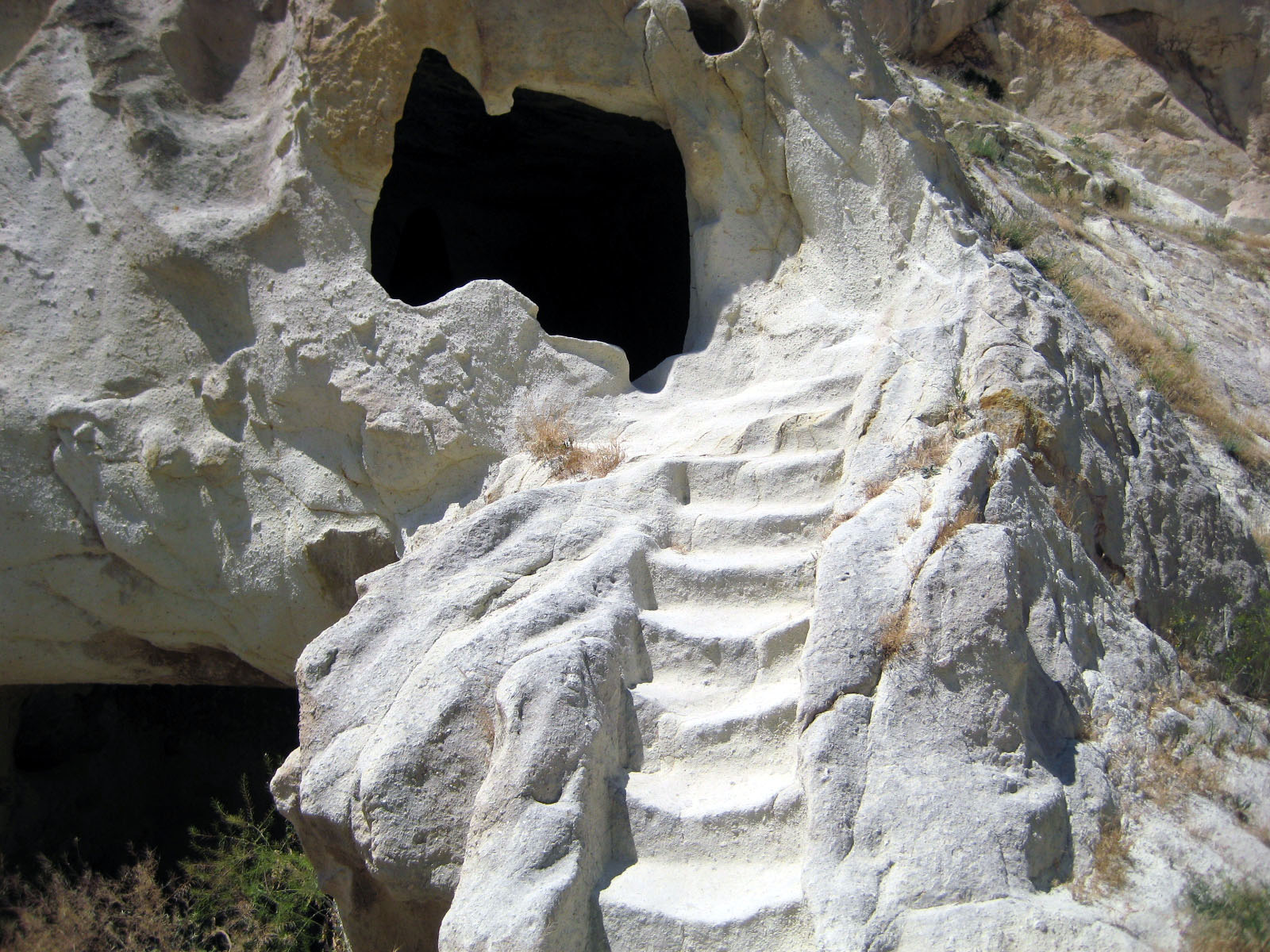 The Cappadocians lived in these caves up to the 1950s; no electricity and no plumbing. They got their water from nearby streams. Tandir ovens were dug into the floors of the caves; first build a fire in the oven, then add the clay pot of food and cover the top of the oven with a clay lid. Some of the houses had primitive staircases, some had footholes in the rockface to climb. Yes, it’s all pretty primitive, but as I said, as I was living in a comfortable suburban house in Connecticut with 2 bathrooms, a full kitchen and a Television, the Cappadocians were living in these prehistoric caves.
The Cappadocians lived in these caves up to the 1950s; no electricity and no plumbing. They got their water from nearby streams. Tandir ovens were dug into the floors of the caves; first build a fire in the oven, then add the clay pot of food and cover the top of the oven with a clay lid. Some of the houses had primitive staircases, some had footholes in the rockface to climb. Yes, it’s all pretty primitive, but as I said, as I was living in a comfortable suburban house in Connecticut with 2 bathrooms, a full kitchen and a Television, the Cappadocians were living in these prehistoric caves.
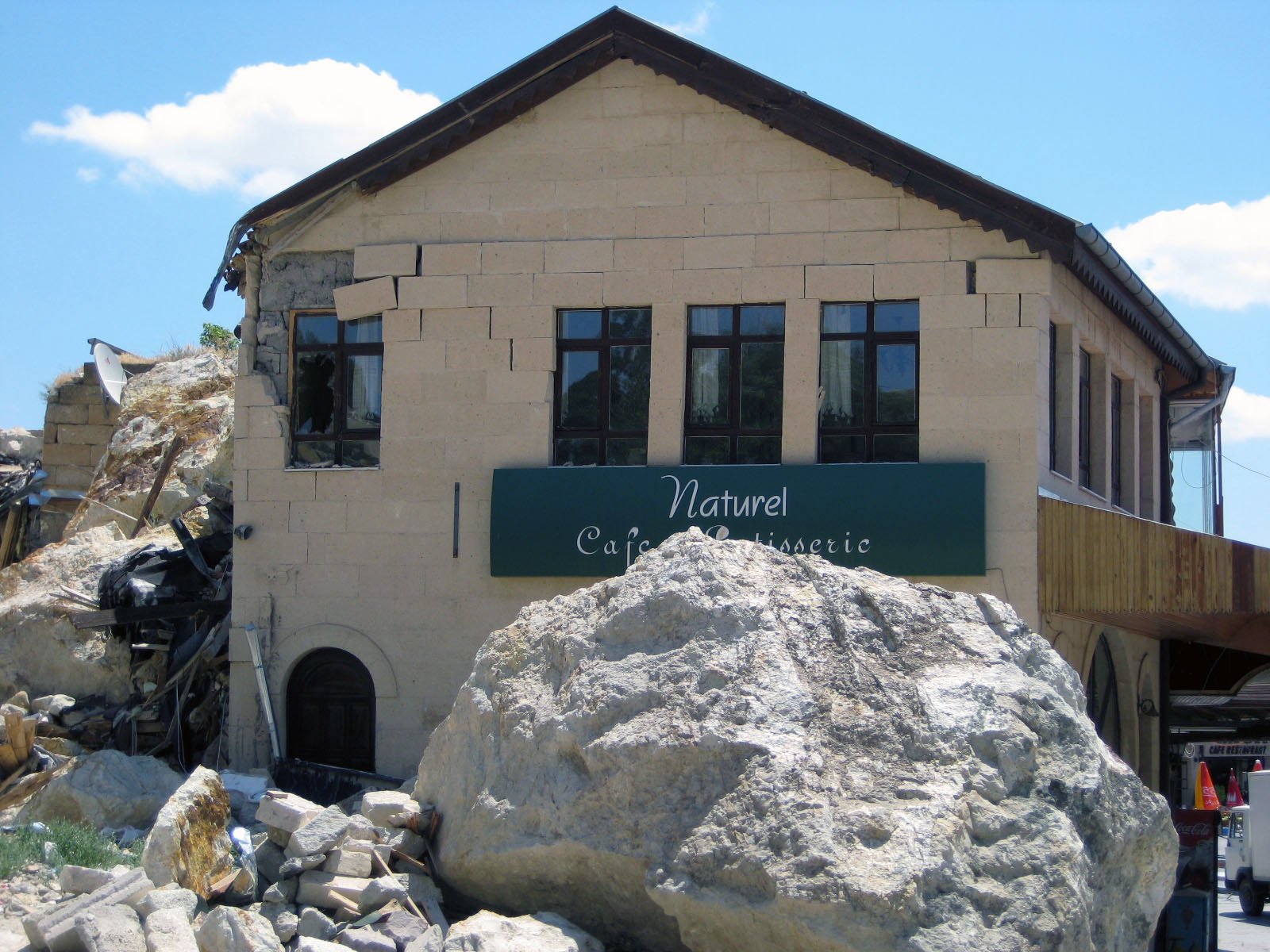 In the late 1950s, housing developments finally pulled them out and the caves sat empty till the 1980s when the region was rediscovered as a natural wonder and a great source for tourism. The old caves are being renovated into posh hotels and luxury homes. If you want a cave home, you have to renovate the old ones. No new digging has been allowed since the 1950s. The excavations made the tufa mountains weak and some of them are dangerous. In our village of Urgup, the mountain side collapsed into a Disco Bar about 3 months ago and killed 3 people. Our guide Alek told us that there are many fissures in the tufa cliffs. “Large trucks and loud music are causing bad vibrations to make the hills collapse”.
In the late 1950s, housing developments finally pulled them out and the caves sat empty till the 1980s when the region was rediscovered as a natural wonder and a great source for tourism. The old caves are being renovated into posh hotels and luxury homes. If you want a cave home, you have to renovate the old ones. No new digging has been allowed since the 1950s. The excavations made the tufa mountains weak and some of them are dangerous. In our village of Urgup, the mountain side collapsed into a Disco Bar about 3 months ago and killed 3 people. Our guide Alek told us that there are many fissures in the tufa cliffs. “Large trucks and loud music are causing bad vibrations to make the hills collapse”.
Our hotel, Yanuk Evleri is located in the old washing square of Urgup. In the 1950s, local women would come here for laundry and gossip. Today it’s a comfortable cave hotel with amazing views. The laundry is done in town these days but we’re still able to get some good local gossip from the hotel staff. Tourism has become very big business here. What was mostly an agricultural community of wheat, potatoes and grapes is now changing to accommodate the new tourism.
Urgup has a new town square, lots of ceramic, rug and souvenir shops and restaurants built just for tourism. Goreme, the tourist center of the area is an unbelievable mecca of Turkish rugs , ceramics, dolls, jewelry and nazar bocuk (the evil eye ornament that actually repels evil and not the other way around).
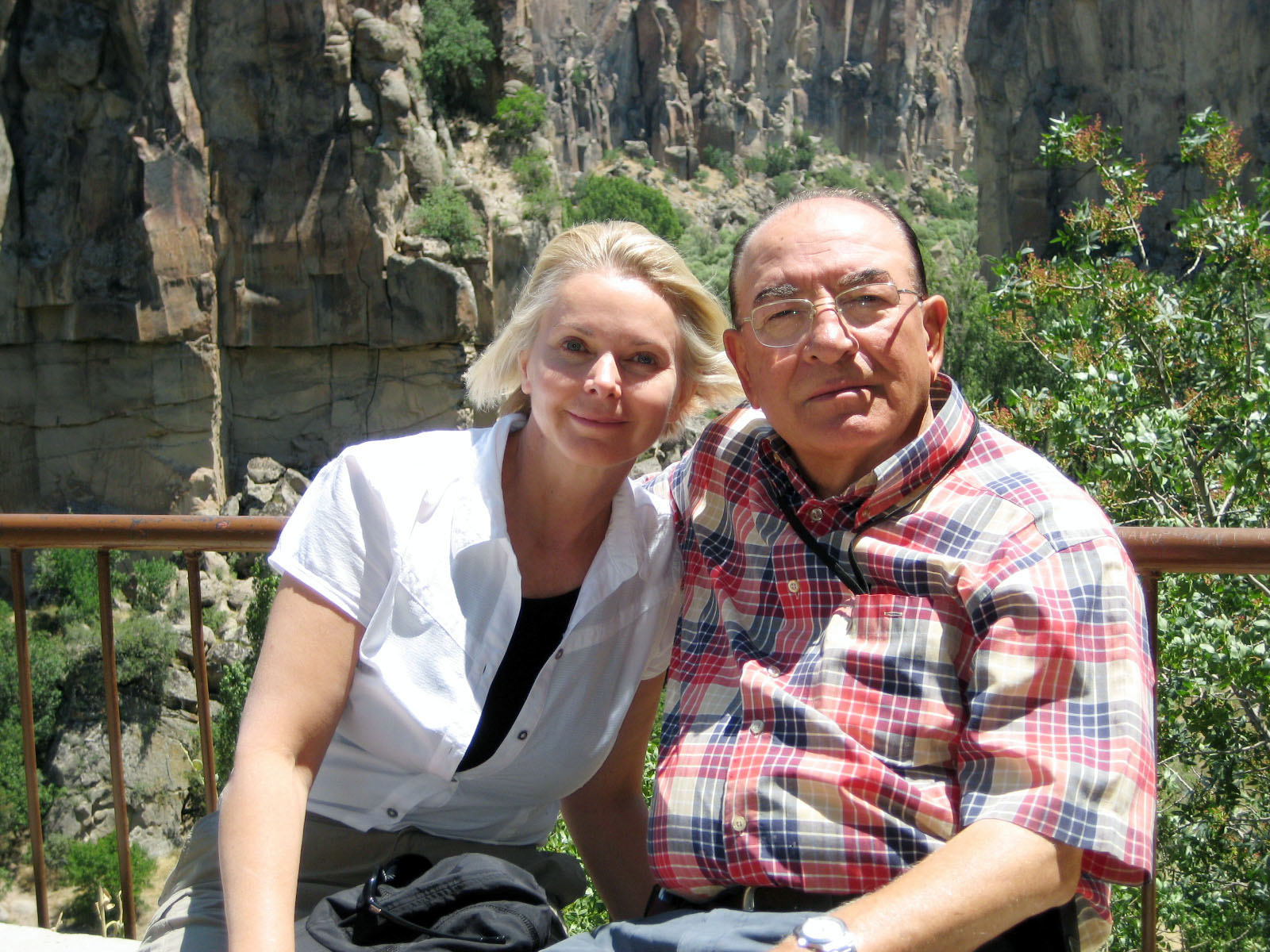 Our guide, Alek, is an amazing man. At 69 years old, he’s so full of energy and so strong, it’s difficult to keep up with him. He’s pretty famous in the area of local guides. CNN came here a couple of weeks ago and hired him; the TV show aired the day before we arrived. He’s escorted quite a few heads of state through the monuments, including US Supreme Court Justice Ruth Bader Ginsberg, who held onto his hand throughout the difficult climbs and at the end said, “Alek, It could not have been any better.” After 2 days with Alek and our driver Mutlu, we totally agreed with Her Honor. It could not have been better.
Our guide, Alek, is an amazing man. At 69 years old, he’s so full of energy and so strong, it’s difficult to keep up with him. He’s pretty famous in the area of local guides. CNN came here a couple of weeks ago and hired him; the TV show aired the day before we arrived. He’s escorted quite a few heads of state through the monuments, including US Supreme Court Justice Ruth Bader Ginsberg, who held onto his hand throughout the difficult climbs and at the end said, “Alek, It could not have been any better.” After 2 days with Alek and our driver Mutlu, we totally agreed with Her Honor. It could not have been better.
Gretchen has been using her family nickname when we introduce oursleves to the Turks. Gretchen is a hard name for them to grasp, but when she says “my name is Gigi”, they’re all smiles. Alek explained Gigi means beautiful in Turkish. It’s mostly used in reference to small children, but another use is in the expression “gigi annee” which means beautiful mistress.
 Our first stop was the Devrent valley. It looked like we were on another planet. Each rock has it’s own personality, human and animal forms. Alek says, “everyone looks at clouds and imagines them to be some sort of human or animal shape. Here in Cappadocia we do the same with the rocks.”
Our first stop was the Devrent valley. It looked like we were on another planet. Each rock has it’s own personality, human and animal forms. Alek says, “everyone looks at clouds and imagines them to be some sort of human or animal shape. Here in Cappadocia we do the same with the rocks.”
Cappadocia was one of the largest Christian communities between the 8th and 12th centuries. There are hundreds of cave churches throughout the region. The most famous one in the Dervent Valley is known as the Deer Church, dedicated to St. Eustace. Eustace was a Roman soldier who, as Alek tells the story, “was hunting the deer until the deer turned to him and said, “Eustace, why are you chasing me. I am Jesus Christ, and as he revealed himself, a cross appeared between the antlers of the deer and Eustace became a believer”. I have no idea why he became a saint. The Café Sant’Eustachio (same Eustace) in Rome serves the best coffee in the world.
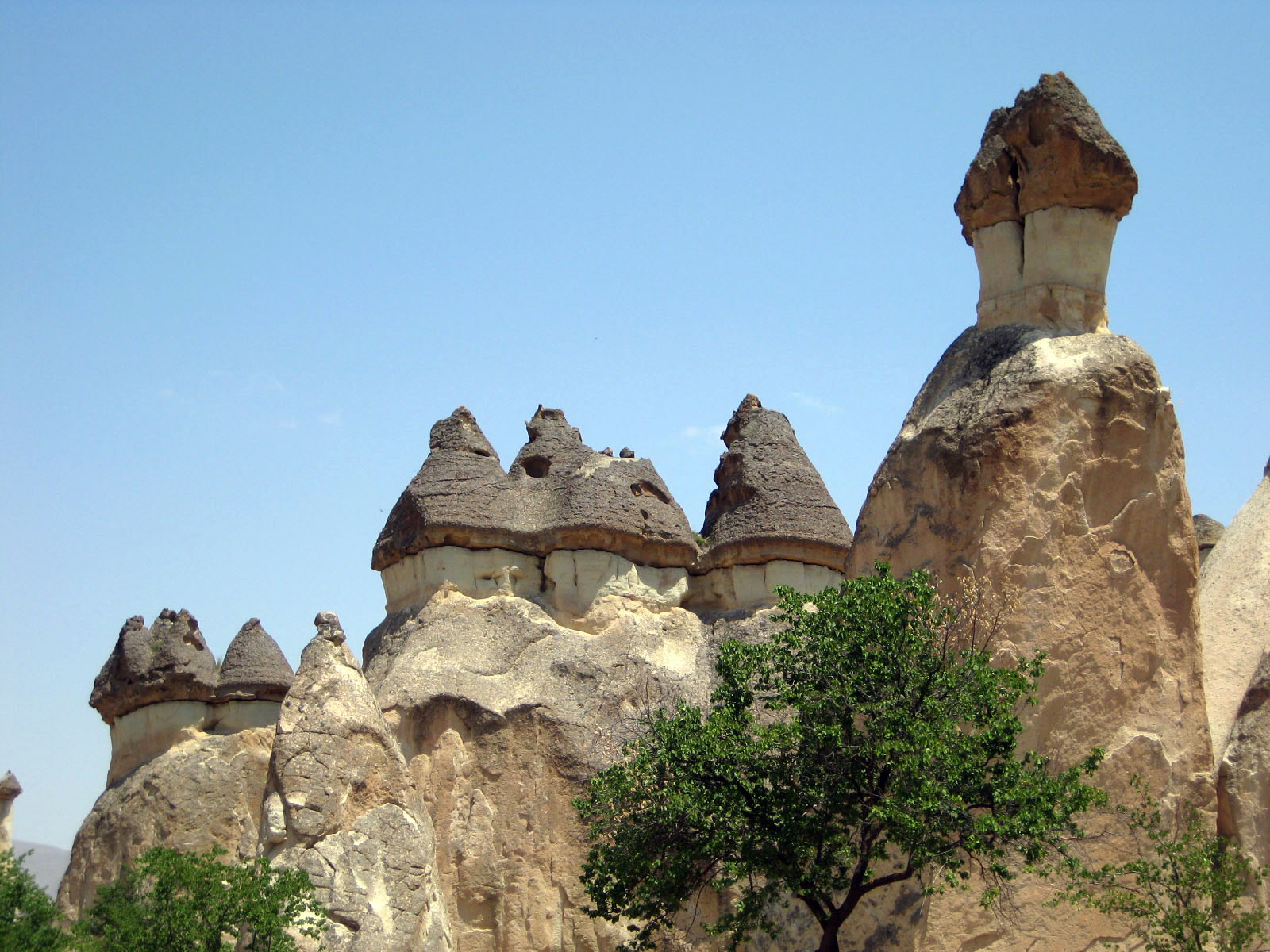 From Dervent we drove to the Passabag Valley, where the rock formations are said to look like Fairy chimneys. Although to me they looked more like giant mushrooms. And then we arrived to the Goreme Open air Museum. The motherlode of Christian cave churches, a complex of more than 30 churches all decorated with amazing 9th-11th century fescos.
From Dervent we drove to the Passabag Valley, where the rock formations are said to look like Fairy chimneys. Although to me they looked more like giant mushrooms. And then we arrived to the Goreme Open air Museum. The motherlode of Christian cave churches, a complex of more than 30 churches all decorated with amazing 9th-11th century fescos.
Goreme was a monastic center between 300-1200 AD. It’s the most visited monastic community in Cappadocia and one of the most famous sites in central Turkey. After seeing churches dripping with gold in other parts of the world it’s so wonderful to get a glimpse of the original concept, built on pure ideals and worshipped by simple people who had no use for world domination, power and wealth. What 1000 years has done to Christianity.
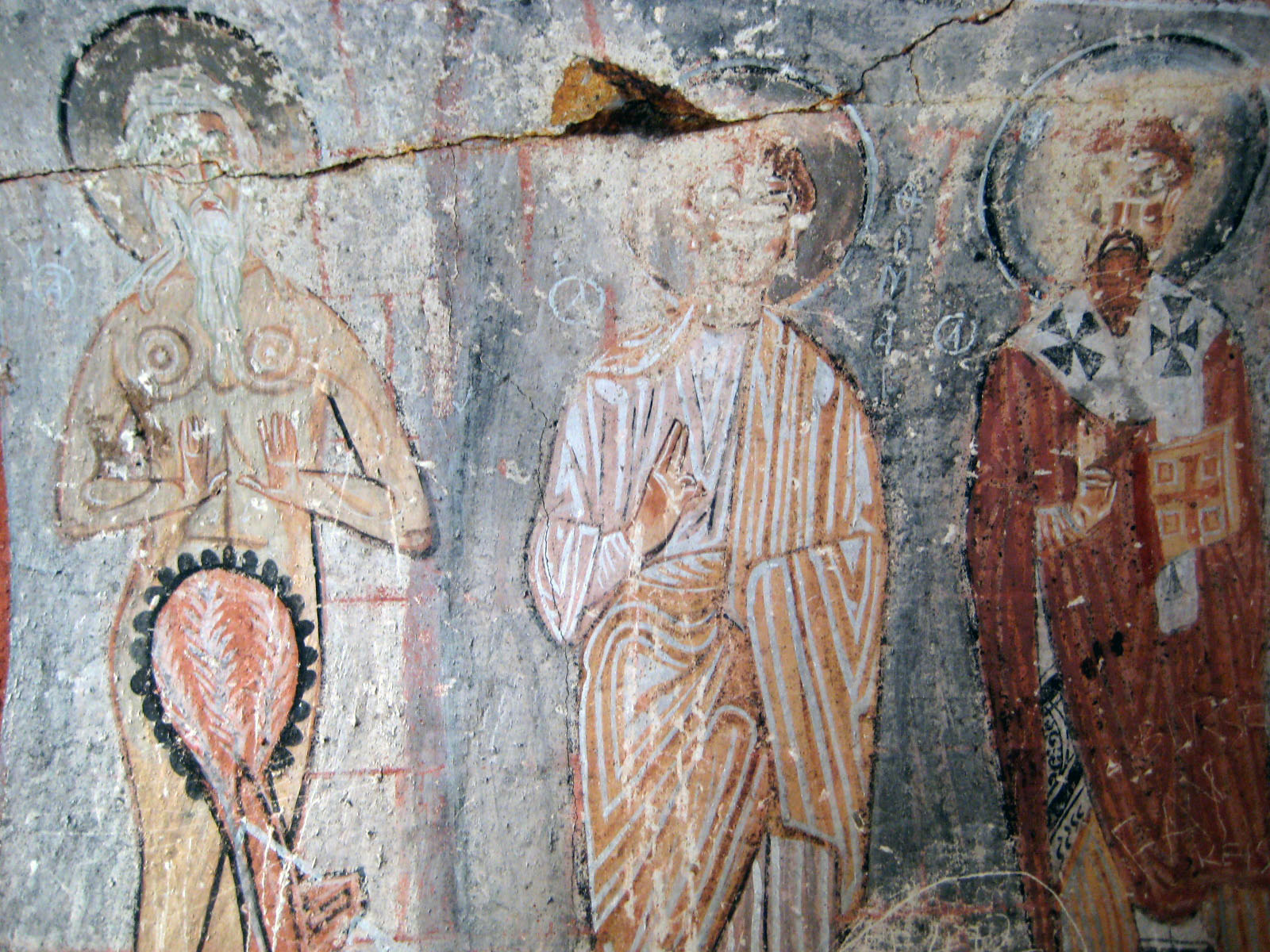 The Turks have given names to the old churches based on the frescos. There is the Apple church, the Snake church, the Sandal church, etc. Our itinerary included the St Basil Church, which does have a fresco of St Basil, the Apple church which does have apples but it also has a fresco of St Onofrious the woman who pleaded to Jesus to make her a man. It happened and she/he became a saint. These days transsexuals are run out of the church. Once again, what has 1000 years has brought us?
The Turks have given names to the old churches based on the frescos. There is the Apple church, the Snake church, the Sandal church, etc. Our itinerary included the St Basil Church, which does have a fresco of St Basil, the Apple church which does have apples but it also has a fresco of St Onofrious the woman who pleaded to Jesus to make her a man. It happened and she/he became a saint. These days transsexuals are run out of the church. Once again, what has 1000 years has brought us?
When we entered the Dark Church, it was, of course, very dark inside, but a few flashlights later we some amazing old frescoes. There was James, the brother of Jesus. According to the early Greek orthodox who lived in these caves, Joseph had a another wife before Mary and fathered three other sons. We know about James because (supposedly) his sarcophagus was found about a year ago, but we don’t know anything about the other two. Hmmm, that should make for a good story.
 There is also a fresco of the baby Jesus getting a bath from two servants named Salome and Imea as Mary relaxes nearby; very charming. And, there is a fresco of Jesus as a teenager; a very handsome lad. These are the only painting of this kind. We see many images of the Baby Jesus, but never getting a bath, nor do we ever see the teenage Jesus. Another of the strange frescoed stories shows the knife wielding disciples listening to an oration from Jesus. In the painting, Peter is cutting the ear off a dwarf for making fun of Jesus. I have no idea what it means, I’m just telling what we were told and what we saw.
There is also a fresco of the baby Jesus getting a bath from two servants named Salome and Imea as Mary relaxes nearby; very charming. And, there is a fresco of Jesus as a teenager; a very handsome lad. These are the only painting of this kind. We see many images of the Baby Jesus, but never getting a bath, nor do we ever see the teenage Jesus. Another of the strange frescoed stories shows the knife wielding disciples listening to an oration from Jesus. In the painting, Peter is cutting the ear off a dwarf for making fun of Jesus. I have no idea what it means, I’m just telling what we were told and what we saw.
A lot of the frescos have been vandalized. The Muslims scratched out the faces because the Koran forbids human images of holy people. The rest of the vandalism has been perpetrated by the locals. Alek is not a big fan of the muslims. He’s a very secular man who believes muslims are ignorant and disrespectful people throwing garbage everywhere and defacing the monuments just for the fun of it.
There’s a big election coming in three weeks and it’s pretty much down to the Democratic party of Attaturk vs the fundalmental conservatives (the party of the Headscarves). The liberals want to bring Turkey into the EU and into modern times. The conservatives want to make the people more religious (just what we need). However, the islam religion in Turkey is pretty liberal. These people hang out in bars and drink alcohol, they dress in modern (secular clothing) and with the exception of all the mosques and the call to prayers 5 times a day, it’s not really unlike a western country (albeit a poor western country).
The concentration of the caves and conical formations isn’t a very large area. It was mostly settled because the soft rock provided good protection from enemy invasion. The Hittites might have dug the first of these caves in 1200 BC when they were under attack from the Phrygians. During the 7th and 8th centuries over 5,000 Christians took refuge from attacking Turks. They dug out rooms for food storage, sleeping quarters and, of course, lots of churches. If any Turks did make it through the cave entrances, protective “man traps” were dug inside of the troglodytic complex. Alek smiled when he pointed out the “mantrap”. It was very dark inside and the attackers would fall over 20 meters down through the holes. It reminded us of Raiders of the Lost Ark.
The two largest cave communities are located at Kaymakli and Derinkuyu. Alek explained that Kaymakli is easier to navigate. Some of the passageways in Derinkuyu require one to get down on all fours. At 69 years old we didn’t want to make Alek get down on all fours.
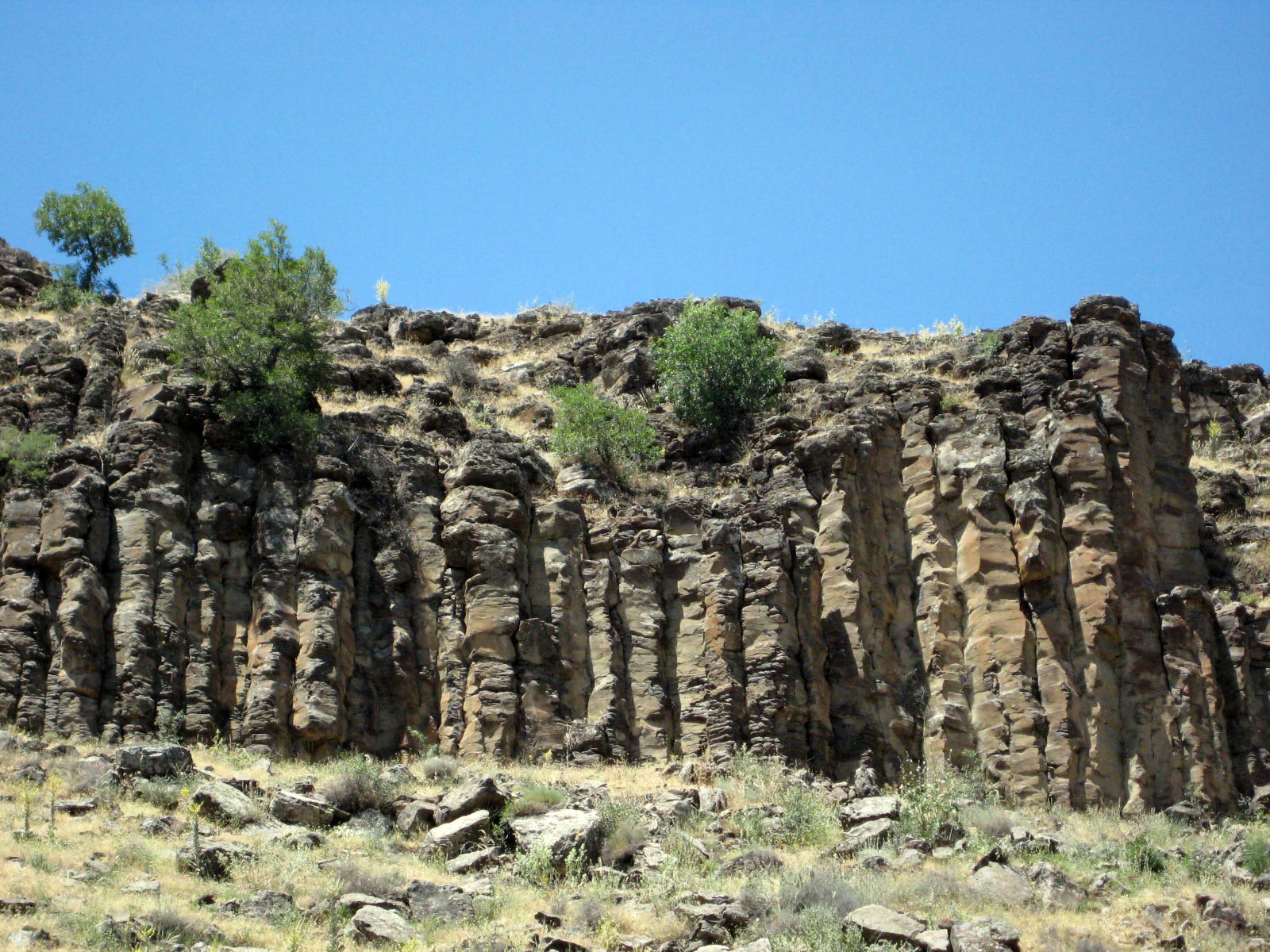 The Ihlara Valley is about an hours drive from Urgup. It’s an old river bed with plunging red rock clifts on either side. It’s very biblical. We had to descend down 40 meters just to get to the hiking trails. At one point in history, there were 105 churches here. Only 15 remain; the rest have fallen down in rock slides. As we hit the bottom, an electric Turkish band was tuning up. Alek tried to explain to them it was a bad idea and would cause more rock slides, but they weren’t really interested in listening to them. Hey, they were jus the paid musicians there to play a gig.
The Ihlara Valley is about an hours drive from Urgup. It’s an old river bed with plunging red rock clifts on either side. It’s very biblical. We had to descend down 40 meters just to get to the hiking trails. At one point in history, there were 105 churches here. Only 15 remain; the rest have fallen down in rock slides. As we hit the bottom, an electric Turkish band was tuning up. Alek tried to explain to them it was a bad idea and would cause more rock slides, but they weren’t really interested in listening to them. Hey, they were jus the paid musicians there to play a gig.
About 6 miles later we were rewarded with a great lunch at a restaurant with tables actually in the river.
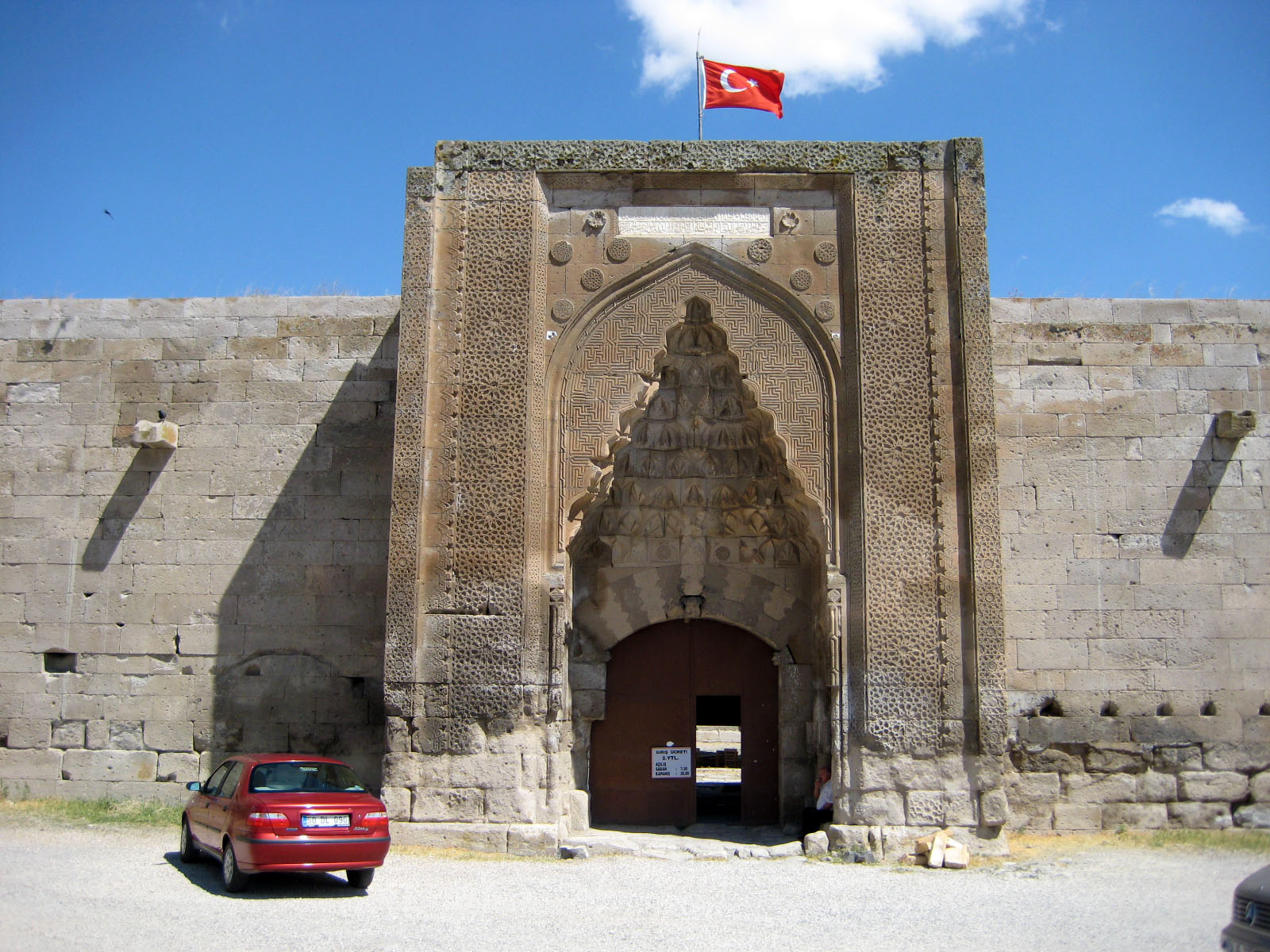 The Silk road connecting China to Asia Minor the Mediterranean has been here since 206 BC. This is the route Marco Polo used to reach China in 1266. I’ve always been fascinated with tales of the silk road. At last, I’m finally here. Sure, it doesn’t look like the old illustrations I saw when I was a kid, but it’s still really cool.
The Silk road connecting China to Asia Minor the Mediterranean has been here since 206 BC. This is the route Marco Polo used to reach China in 1266. I’ve always been fascinated with tales of the silk road. At last, I’m finally here. Sure, it doesn’t look like the old illustrations I saw when I was a kid, but it’s still really cool.
Caravanserais (fortresses of stone) built along the Silk Road offered food, housing, shelter, protection from thieves, and a place to trade goods. The large Caravanserais were built at a distance of about 30-40 kilometers from one another, to be covered in 8-10 hours on foot, but as trade grew, smaller Caravanserais were added to the route, kind of like “overflow” hotels. Sometimes the caravans included 1000 camels. A scout would ride in to announce the arrival and the “hotel manager” would tell him how much room was available. If the big one couldn’t handle the entire group, he’d send the rest to the overflow hotels down the road. It’s just like what goes on today with big conferences.
In the courtyard, people would set up trades or just relax. The grand hall was for eating and sleeping; men and women on a raised platform and camels beside them in the dirt. It was smelly mixture but at least you could keep an eye of your goods (and camels).
In 1997 a group of explorers walked on the Silk Road trying to imitate ancient caravans with their camels, it took them around 14 months to travel from China to Turkey.
 Outside of the town of Uchisar is the Pigeon Valley, a large expanse of white tufa where thousands of pigeon houses have been carved into the cliffs. Some people say it’s the largest collection of pigeon lofts in the world, a dubious distinction. The pigeons were raised for the their poop. It’s considered very valuable and was the only fertilizer used here up to the 1960s. Turkish farmers who still use pigeon poop will tell you it’s what makes Cappadocian fruit the sweetest in the world. Most farmers these days however, use whatever they can get from the agricultural supplier.
Outside of the town of Uchisar is the Pigeon Valley, a large expanse of white tufa where thousands of pigeon houses have been carved into the cliffs. Some people say it’s the largest collection of pigeon lofts in the world, a dubious distinction. The pigeons were raised for the their poop. It’s considered very valuable and was the only fertilizer used here up to the 1960s. Turkish farmers who still use pigeon poop will tell you it’s what makes Cappadocian fruit the sweetest in the world. Most farmers these days however, use whatever they can get from the agricultural supplier.
 In 1999 after the devastating earthquake near Ankara, US President Bill Clinton made a trip to Turkey. The Mayor of Uchisar invited President Bill to see his beautiful village. He even changed the name of Pigeon Valley to Clinton Valley. It all sounded great, but Bill Clinton never made it here and the name never stuck. I’m sure there’s a joke somewhere here. Let’s see, Bill Clinton and the largest collection of pigeon poop in the world. I’ll have to think about it a little longer.
In 1999 after the devastating earthquake near Ankara, US President Bill Clinton made a trip to Turkey. The Mayor of Uchisar invited President Bill to see his beautiful village. He even changed the name of Pigeon Valley to Clinton Valley. It all sounded great, but Bill Clinton never made it here and the name never stuck. I’m sure there’s a joke somewhere here. Let’s see, Bill Clinton and the largest collection of pigeon poop in the world. I’ll have to think about it a little longer.
After 3 days in the hot Cappadocian sun, we relaxed on our last day and walked around the village of Urgup. Turkish shop vendors love tourists and have honed the art of separating you from your money. First , there is the “Hello, where are you from?” No matter where you tell them, they’ll certainly reply, “Oh, I have a cousin (or brother, uncle, friend or valued customer) near you.” After 10-15 minutes of their interest in your lives and background, they’ll invite you into the shop for tea, apple tea or coffee. If you do accept the invitation, you’re trapped in there for at least an hour. They’ll assure you they are not selling you anything, but after you drink the tea they’ll make you feel obligated to look at their beautiful (rugs, ceramics, clothing or jewelry). And after they have exhausted you for an hour, then comes the line, “after I have shared tea with you and showed you all of my goods, how could you not buy something from me?” Best thing to do it smile and walk on by.
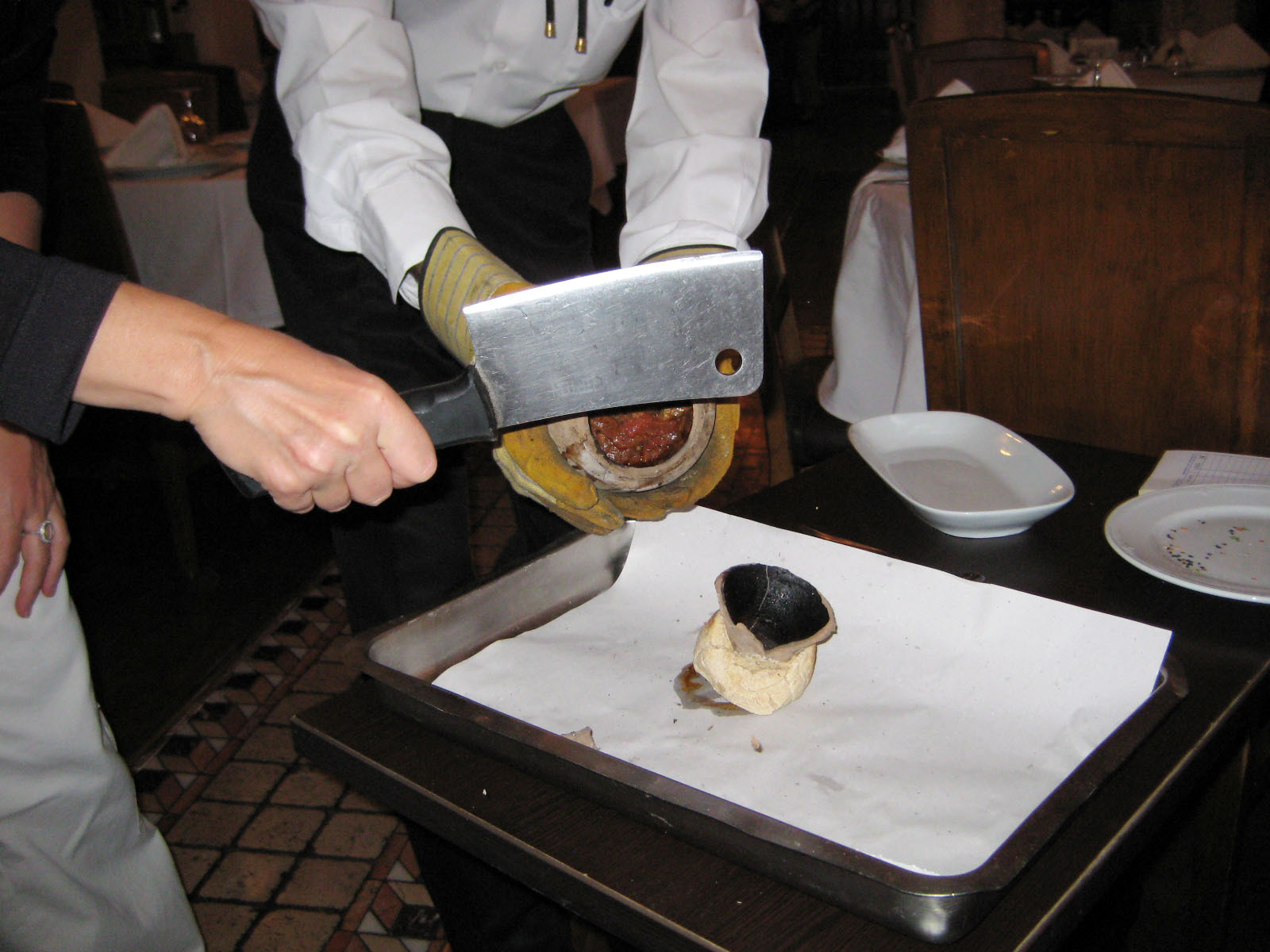 Urgup is also the home to the international prize winning Turasan Kapadokya Winery. Their wine is actually very good. We tried the 2005 Kalecik Karasi, a tasty fruity Pinot style wine, perfect for a hot afternoon in Cappadocia. We also found an amazing local restaurant called Somine (the Turkish name for Chimney). We went back twice. The testi kabab, braised lamb, tomato, onion and spice cooked for 5 hrs in a clay pot was especially delicious. When they bring it to the table, you get to crack open the pot with the back side of a meat cleaver. Gretchen dined on lamb cutlets stuffed with spiced bread and capers. Speaking of the bread. They bring large hot pita style loaves baked in a wood oven. As soon as the loaf gets cold, they bring another.
Urgup is also the home to the international prize winning Turasan Kapadokya Winery. Their wine is actually very good. We tried the 2005 Kalecik Karasi, a tasty fruity Pinot style wine, perfect for a hot afternoon in Cappadocia. We also found an amazing local restaurant called Somine (the Turkish name for Chimney). We went back twice. The testi kabab, braised lamb, tomato, onion and spice cooked for 5 hrs in a clay pot was especially delicious. When they bring it to the table, you get to crack open the pot with the back side of a meat cleaver. Gretchen dined on lamb cutlets stuffed with spiced bread and capers. Speaking of the bread. They bring large hot pita style loaves baked in a wood oven. As soon as the loaf gets cold, they bring another.
We finished out day in Urgup with a shave. Nothing like a visit to the Turkish barber. He was at least 75 years old, probably had been shaving faces for the past 60 years. First he dabbed a relaxing cream on my face and massaged it for a few minutes. Next came the shaving cream, a soap that smelled like an old laundry. He must have worked it into my skin for 3-4 minutes before he took the razor to hand. After one shave, he lathered me up again with the same brush technique, and then the second shave. After washing my face clean of soap, I was treated to a generous wash of something like bay rum. Ohh did it sting..
The experience got strange when he took a long piece of wire topped with a gauze ball and dipped it into a sterno-like petroleum product, and then, he lit it on fire. When the alcohol burned off and the flame was just right, he held it to my left ear and whipped it into my ear canal with the action one might use to snap a whip. I could feel the small hairs inside my ear sizzle. After whipping the flaming ball into my right ear, he then applied an alcohol rub.
After a head massage came the neck massage, then the back and arm massage. Then the hand and finger massage. Then he smiled and took my head into his hands. I kind of knew what was going to happen, and as he nodded, his hands whipped my neck and cracked every joint from my head to my ass. We both giggled. And then he did it again. I’ve gone to chiropractors for years and never had a neck crack like this.
Gretchen, in the meantime was fighting off the advances of the barbershop locals, but as the barber soaked my head in the bay rum product and combed my hair, they all looked at me and said, “now he looks like a handsome Turkish man.”
You must be logged in to post a comment.